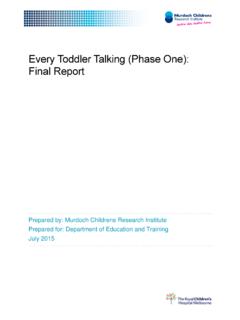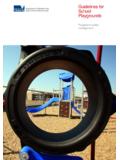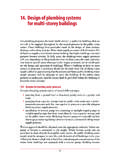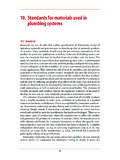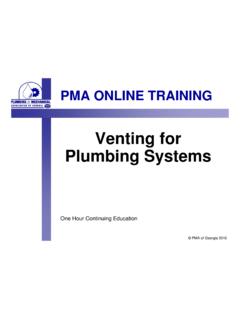Transcription of Welcome to the safe@work Plumbing Module.
1 Welcome to the safe @ work Plumbing module . Have you read the General module , completed the test and gained your safe @ work General certificate? The Plumbing module should be done AFTER the General module or Review module . If it is some time since you have completed the General module you should read the Review module . The test for the Plumbing module contains some questions based on the Review module . There are common hazards in the Plumbing industry. It is important to learn about these hazards and how they can be controlled so people at work are not exposed to risk.
2 The Plumbing module contains information on: Powered Tools and Hand Tools Prevention of Falls Manual Handling Hazardous Substances Biological Hazards Electricity Burns Trenches and Confined Spaces Sunburn and Heat Stress Within the Plumbing industry, you may be involved in a range of work activities such as: installing hot water and gas services replacing guttering and downpipes laying and connecting water and sewage pipes fixing sink or sewage blockages. Your employer must explain each task before you start work on it.
3 You must be provided with instruction, training and supervision. You must know the first aid and emergency arrangements too, so if anything goes wrong you will know what to do. Key Point It is important that your employer has taken action to control risks. You must know and follow safe working procedures not just for your own safety, but also for the safety of others working with you. This publication is based on WorkSafe Smart Move (copyright State of Western Australia) published by Worksafe, Department of Consumer and Employment Protection, Western Australia ( ) Powered Tools and Hand Tools Note: Students in work experience programs must NOT operate powered tools.
4 This information is designed to give students an understanding of the hazard and some of its risk control measures. Powered tools and hand tools are used to carry out everyday tasks in the Plumbing industry. For example, plumbers will often use tools such as electric drills, welding equipment, grinding tools, pipe cutters and hacksaws. Powered tools present serious risks if not used and maintained correctly. The most common injuries are to hands and fingers, which could be cut, broken or crushed. Eye injuries are often caused by pieces of material flying off while being cut or ground by powered tools.
5 Such injuries can lead to long periods away from work and sometimes result in permanent disability. While some portable equipment (such as cement mixers) may be petrol driven, electricity is the usual power source. Electrical equipment exposed to outdoor working conditions should always be checked before use. Electrical leads can easily become split, frayed or pierced when used out of doors. If this happens, the tool must not be used until the lead has been replaced. Key Point Any faulty item of electrical equipment must be immediately withdrawn from use it should be tagged (FAULTY DO NOT USE) and removed from service until it has been repaired.
6 Hand tools can also be dangerous if they are not used correctly. A common cause of accidents with hand tools is using the wrong tool for the job. Your employer should make sure you are provided with the appropriate tools for each task, and should instruct you in how to use them safely. When hazards cannot be eliminated or sufficiently reduced by engineering controls or safe working procedures alone, you may need to wear personal protective equipment (PPE) to improve protection. PPE may include safety glasses or goggles, earplugs or earmuffs, protective gloves, overalls or other close fitting clothing.
7 Safety shoes or boots with reinforced toe-caps will protect your feet if any heavy or sharp items are dropped. Your employer must: have a maintenance program to make sure all tools are in safe working order train you to use tools and equipment before you use it, and make sure you are supervised provide any personal protective equipment needed and tell you how to wear and use it correctly. This publication is based on WorkSafe Smart Move (copyright State of Western Australia) published by Worksafe, Department of Consumer and Employment Protection, Western Australia ( ) What you should do When you are using hand tools, you must follow safe work procedures as instructed by your employer or supervisor.
8 These may include: wearing personal protective equipment provided by your employer operating the equipment correctly and safely according to your training concentrating on the job, as distractions can contribute to injuries Prevention of Falls Note: Students in work experience programs must NOT perform work at height. This information is designed to give students an understanding of the hazard and some of its risk control measures. Falls are a major cause of workplace deaths each year. Victoria now has Regulations to cover all work where a fall of more than 2 metres could occur.
9 These Regulations aim to reduce the number of fall-related incidents. Many Plumbing tasks are carried out at heights: these include work on roofs, installing or repairing gutters and downpipes, accessing roof cavities through manholes. Employers must control the risks of falls in the most effective way practicable. The first questions an employer should ask is: Does this work have to be done at height? Is there a way of doing the job from the ground? ' safe work methods must be established before a worker is required to access the task.
10 The options for work at height (in their preferred order) are: use fall protection devices (such as temporary work platforms or scaffolding) use a work positioning system (such as a rope access system to position and support the worker for the duration of the task) use a fall injury prevention system (such as an industrial safety net or a safety harness) use a ladder, as long as it can be employed safely for the duration of the task this will require procedures and training for the workers who will use it Key Point Ladders should always be visually inspected prior to use, to make sure no damage or wear has occurred that could make them unsafe.








